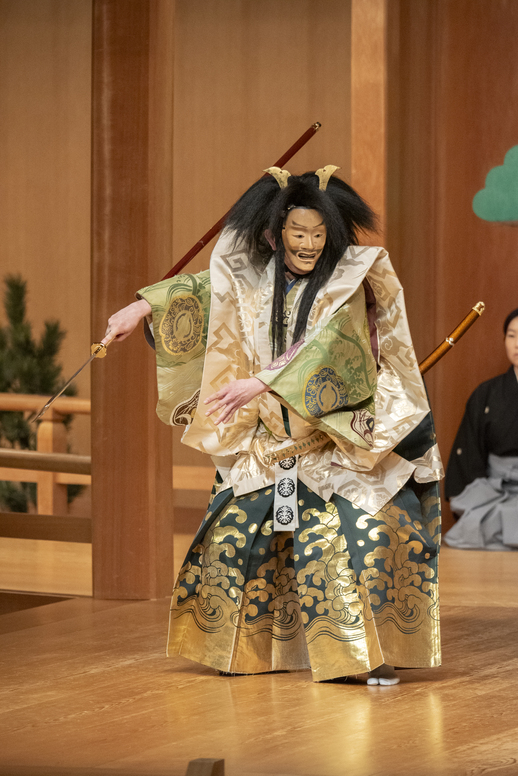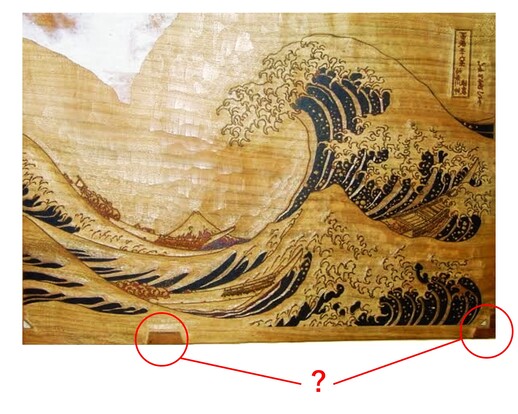2025.08.21
伝検通信(メルマガ)週刊メールマガジン「伝検通信」 第70号
週刊メールマガジン「伝検通信」第70号をお届けします。
今週のトップ記事は、能楽鑑賞体験記です。初心者目線で能の魅力をお伝えします。
「クイズで肩慣らし」は、前回クイズの答え・解説と、「芸能」の問題です。
第2回伝検は終了しましたが、第3回伝検(2級、3級)は11月1日(土)から来年1月12日(月・祝日)まで実施します。申し込みは1カ月前の10月1日(水)開始です。ぜひ、下記、公式テキスト、オンライン講座をご活用の上、チャレンジしてみてください。
伝検公式教材・参考書・サイト https://denken-test.jp/
目次
・ 能楽鑑賞体験記―国立能楽堂で初心者向け公演
・ 「クイズで肩慣らし」 第69回=「芸能」
・ 伝検協会だより
能楽鑑賞体験記―国立能楽堂で初心者向け公演

「船弁慶」平知盛の亡霊(提供=国立能楽堂)
伝検では伝統芸能として、能楽、人形浄瑠璃文楽、歌舞伎の三つを主に学びますが、その中で、難しく感じられがちなのが能楽ではないでしょうか。一般的に、①せりふが聞き取りづらい②ストーリーが分かりにくい③ゆったりしていて眠くなる―といったイメージがあると思われます。
そこで、初心者の視点からそのイメージを検証すべく、7月下旬に東京・千駄ケ谷の国立能楽堂へ足を運びました。建築家・大江宏の設計で1983年に完成した建物は、伝統的でありながら、どこかモダンな印象を受けます。
今回鑑賞したのは、「国立能楽堂ショーケース」というもの。能楽を初めて見る人に向けて、前述のイメージを払拭することを目的とした公演形式です。能と狂言をセットで楽しめて、料金は約3000円。上演時間も90分程度で、集中して鑑賞しやすくなっています。客席には外国人の姿もあり、日本人も能楽に慣れていない様子の人が多く見られました。客席には、前席の背もたれにモニターが設置されています。せりふに合わせて、現代語訳・詞章(原語)・英語の3種類の字幕を選んで表示できます。隣に座っていた、日本語を勉強中というオーストラリア人留学生は、英語字幕を読みながら狂言で笑っていました。また、開演30分前には出演者による「プレトーク」があり、演目をより楽しむための知識や背景、ストーリーを分かりやすく解説してくれます。
まず上演されたのは、狂言の「寝音曲(ねおんぎょく)」。主人の耳にたまたま聞こえた謡(うたい)を太郎冠者(たろうかじゃ=狂言に出てくる主要キャラクターで、筆頭の家来)に無理やり謡わせようとする話です。太郎冠者は「酒を飲まないと謡えない」「妻の膝に寝転がらないと謡えない」と言って回避しようとします。仕事で面倒なことを頼まれ、ごまかそうとしたものの、ボロが出て怒られてしまうという展開は、現代の私たちにも共感できる内容で、客席から笑いが起きていました。
続いて鑑賞した能「鵜飼(うかい)」は、能らしい幽玄さが存分に感じられる演目で、前半と後半で予想外の展開を見せます。とくに「鵜ノ段」という有名な場面では、鵜飼の老人が自ら地獄に落ちた理由である漁を再現しているうちに、中毒のようにのめり込んでいく様子が描かれます。リズミカルな笛や鼓の音が重なり合い、不思議な感覚に包まれました。江戸時代の俳人・松尾芭蕉がこの演目を背景に詠んだ句「おもしろうて やがて悲しき 鵜舟かな」の意味が理解できた気がします。
別の日に見た能の「船弁慶(ふなべんけい)」は、さらに初心者向けの演目だと感じました。前半の静御前の悲しげな舞、後半の平知盛の亡霊と弁慶らが船上で戦うという「静と動」のコントラストが鮮やかで、囃子(はやし)の迫力も相まって、観客は身を乗り出して鑑賞していました。源義経を演じた子方(子役)の小学生が懸命に演じる姿も印象的でした。
観劇は、国立能楽堂の公式サイトから事前にインターネット予約が可能。客席を選ぶ際は、初心者は正面席がお勧めです。ワキ正面席は役者同士のやりとりが見づらいのですが、気に入った演目を別角度から楽しむ際にはよいかもしれません。
能楽は現存する世界最古の演劇。その重みを全身で浴びる不思議な感覚を劇場で味わってみてはいかがでしょうか。
「クイズで肩慣らし」 第69回=「芸能」
~伝統文化に関するさまざまな話題をクイズ形式でお届けします~

この演目では、寂寥感を誘う小道具として、すすきが印象的に用いられる
第69回
問題:「伊勢物語」を題材とした世阿弥の代表作で、女の霊が旅の僧に亡き夫との思い出を語り、形見の装束で舞う能の演目は何でしょう。(答えと解説は次号で)

錦絵の版木にある2カ所の目印
【前回の問題と答え・解説】
問題:江戸中期、絵暦交換会の流行をきっかけに「錦絵」と呼ばれる高度な多色摺(ずり)木版画が誕生しました。それを可能にした版木に付ける2カ所の目印を何と呼ぶでしょう。
答え:見当
解説:紅摺絵から錦絵へ発展した高度な多色摺(ずり)木版画は、鈴木春信らが名作を多く世に送り出しましたが、何度も色を重ねて刷るうちに、彩色の位置がずれてしまう問題が生じていました。そこで「見当」と呼ばれる目印を版木の端や角に彫って、その位置に紙を合わせることで、ずれを解決したそうです。「見当をつける」や「見当違い」という言葉はここから生まれました。見当の発案には平賀源内が関わっていたともいわれています。
伝検協会だより
▼伝検の第2回試験が8月17日、終了しました。2カ月半の試験期間中、志願者数は257人で、243人に受験していただきました。このうち、2級は34人、3級は60人が見事に合格されました。3級合格の方には次は2級への挑戦を、残念ながらあと一歩及ばなかった方には再挑戦を期待します。第3回伝検(2級、3級)は11月1日(土)から来年1月12日(月・祝日)まで実施します。申し込みは1カ月前の10月1日(水)開始です。
以下は第2回試験結果の速報データです。詳細は追って公式サイトに掲載します。
申込期間: 2025年5月1日~8月14日
受験期間: 2025年6月1日~8月17日
志願者数: 257人(2級105人、3級152人)
受験者数: 243人(2級100人、3級143人)
合格者数: 94人(2級34人、3級60人)
合格率 : 2級34%、3級42%
最高正答率:2級90%、3級93%
▼このほど、能楽を複数回、鑑賞しました。どの日も満席でした。予約専用サイトで解禁日に予約しましたが、すでにいい席は埋まっていました。客席には外国人もおり、伝統芸能に魅了されるファンは絶えません。しかし、会場として使われていた東京・国立劇場の建て替えが進んでおらず、現在は公演数も限られています。この状況が続くと伝統芸能を支えている出演者、裏方さん、道具を作る職人さんに影響が出て廃業などになれば取り返しがつかなくなります。一刻も早い解決が望まれます。
【編集後記】
お盆休みは皆さん、どのように過ごされましたか。私は本通信64号のトップ記事で紹介された歌舞伎の「一幕見席」に行ってきました。歌舞伎座は伝検協会の入る時事通信ビルから目と鼻の先にありますが、これまでなかなか行けなかったので、よい機会となりました。これから涼しくなると、観劇に加えて、博物館や美術館にも出かけやすくなります。ぜひ日本の伝統文化に触れてみてください。
【English version】
Weekly e-mail magazine "Denken Tsushin" No. 70
We deliver the weekly e-mail magazine "Denken Tsushin" No. 70.
This week's top article is an experience book of watching Noh. I will tell you the charm of Noh from a beginner's point of view.
“Let's Practice with Quizzes” is the answer and explanation of the previous quiz and the question of "performing arts".
The second Denken has ended, but the third Denken (second and third grades) will be held from November 1 (Saturday) to January 12 (Monday, national holiday) next year. Applications will start one month before, on October 1 (Wednesday). Please try it by using the following official text and online course.
Official teaching materials, reference books, and websites are available here. https://denken-test.jp/official_text/
Contents
・ Nogaku Viewing Experience - Performance for beginners at National Noh Theater
・“Let's Practice with Quizzes” No. 69 : Performing Arts
・ Denken Association News
Noh Performance Viewing Experience: Beginner-Friendly Performance at the National Noh Theatre

"Funa Benkei": The Ghost of Tairano Tomomori (Provided by National Noh Theatre)
At the Denken, the three traditional performing arts of Nohgaku, Ningyo Joruri Bunraku, and Kabuki are mainly studied. Among them, I think that Nogaku tends to be seen as difficult. In general, it is thought that there is an image that (1) dialogue is difficult to hear, (2) stories are difficult to understand, and (3) The movement is slow and makes me sleepy..
In late July, I visited the National Noh Theatre in Sendagaya, Tokyo Prefecture, to examine the image from a beginner's point of view. The building, designed by the architect Hiroshi Oe and completed in 1983, is both traditional and somewhat modern.
What I saw this time was the "National Noh Theatre Showcase." The purpose of this performance is to dispel the image of Nogaku for those who have never seen it before. You can enjoy Nohgaku and Kyogen as a set, for a fee of about 3000 yen. The performance lasts for about 90 minutes, making it easy to concentrate on the performance. There were foreigners in the audience seats, and many Japanese seemed to be unfamiliar with Nohgaku. In the audience seats, a monitor is installed on the back of the front seat. Three types of subtitles can be selected and displayed to match the dialogue: modern translation, verse (original language), and English. An Australian student sitting next to me, who was studying Japanese, was laughing at Kyogen while reading the English subtitles. There is also a "pre-talk" by the performers 30 minutes before the performance, which explains the knowledge, background, and story in an easy-to-understand manner so that you can enjoy the performance even more.
The first to be performed was the Kyogen play "Neon-gyoku" (Sleeping Music). It is a story of a master trying to force Tarokaja (the main character in Kyogen, the head retainer) to sing a Utai (Noh song) that he happened to hear. Tarokaja tries to avoid it by saying, "You can't sing unless you drink," or "You can't sing unless you lie on your wife's lap." He was asked to do something troublesome at work, and he tried to cheat on it, but he got into trouble and got angry. The story resonated with us today, and there was laughter from the audience.
The Noh play "Ukai" (cormorant fishing), which I watched next, is a program in which I can fully feel the subtle and profound elements of Noh, with unexpected developments in the first and second halves. In the famous scene called "Unodan" (Section of Cormorant), in particular, the old cormorant fisherman is depicted as indulging in an addiction while re-creating the fishing that was the reason he went to hell himself. The sound of the rhythmic flute and drum overlapped, and I was surrounded by a strange feeling. I think I understood the meaning of the haiku that Basho Matsuo, a haiku poet in the Edo period, composed against the background of this program: "It is interesting, but before long it is sad. Is it cormorant boat?"
Another day I saw a Noh play called "Funa Benkei," which I felt was even more aimed at beginners. In the first half of the play, Shizuka Gozen performed a sad dance. In the second half, the ghost of Taira no Tomomori and Benkei fought on a boat. The contrast between "SEI" and "DOU" was vivid. Coupled with the power of hayashi (Japanese musical accompaniment), the audience leaned forward and watched the play. I was also impressed by the hard work of the children who played Yoshitsune Minamoto.
Reservations can be made in advance on the National Noh Theatre's official website. When choosing seats for the audience, I recommend the front seats for beginners. Waki The front seats are hard to see the interaction between actors, but it may be good when you enjoy your favorite program from a different angle.
Nohgaku is the oldest existing form of theatre in the world. Why don't you enjoy the mysterious feeling of being exposed to the weight of Nhogaku throughout your body?
“Let's Practice with Quizzes” No. 69 = ‘ Performing Arts’
~ We will deliver various topics related to traditional culture in a quiz format ~

69th
Question: What is the Program of Noh based on the Ise Monogatari (The Tales of Ise), in which a female spirit talks to a traveling monk about her memories with her late husband, and dances in a memento costume? (Answer and commentary in next issue.)

Two marks on the woodblock of nishiki-e
[Previous question and answer / explanation]
question: In the mid-Edo period, the popularity of picture-calendar exchange parties led to the creation of high-quality multi-color woodblock prints called nishiki-e. What are the two marks on the printing blocks that made this possible?
Answer: Kentou
Explanation: Suzuki Harunobu and others produced many masterpieces of the advanced multi-color woodblock prints that developed from the Benisuri-e to the Nishiki-e. However, there was a problem that the position of the colors shifted as the colors were printed over and over again. Therefore, it is said that the shift was solved by engraving a mark called "kento" on the edge or corner of the printing block and aligning the paper to that position. The words "kento wo tsukeru" and "kento chigai" originated from this. It is also said that Hiraga Gennai was involved in the idea of kento.
Denken Association News
▼ On August 17th, the second examination of the transmission test ended. During the two and-a-half-month examination period, the number of applicants was 257 and 243 people took the test. Of these, 34 passed the second level and 60 passed the third level. Those who passed the third level are expected to challenge the second level next time, and those who are unfortunately one step behind are expected to challenge again. The third transmission test (second and third levels) will be held from November 1st (Saturday) to January 12th (Monday and holiday) next year. The application will start on October 1st (Wednesday), one month before.
The following is the preliminary data of the 2nd examination results. The details will be posted on the official website later.
Application period: May 1 to August 14, 2025
Examination period: June 1 to August 17, 2025
Number of applicants: 257 (105 for Grade 2, 152 for Grade 3)
Number of examinees: 243 (100 for Grade 2, 143 for Grade 3)
Number of successful applicants: 94 (34 for Grade 2, 60 for Grade 3)
Pass rate: Grade 2:34%, Grade 3:42%
Highest percentage of correct answers: 90% for Grade 2, 93% for Grade 3
▼ Recently, I have watched Nohgaku several times. It was full on every day. I made a reservation on the opening day on the reservation site, but all the good seats were already taken. There are foreigners in the audience seats, and there are endless fans who are fascinated by the traditional performing arts. However, the reconstruction of the National Theater in Tokyo, which was used as the venue, has not progressed, and the number of performances is currently limited. If this situation continues, it will affect the performers, the backstage people, and the craftsmen who make the tools that support the traditional performing arts, and if it goes out of business, it will be irreparable. It is hoped that it will be solved as soon as possible.
[Editorial Postscript]
How did everyone spend the Obon holiday? I went to the "one act Viewing Seat" of Kabuki, which was introduced in the top article of the 64th issue of this newsletter. Kabukiza Theater is just a stone's throw away from the Jiji Press Building, which houses the Denken Kyokai Association. It was a good opportunity because I hadn't been able to go before. When it gets cooler from now on, it will be easier to go to museums and art galleries in addition to watching plays. Please come in contact with Japanese traditional culture.
カテゴリー: 伝検通信(メルマガ)
関連タグ: #芸能





